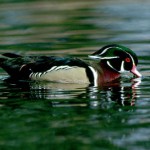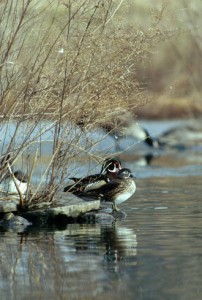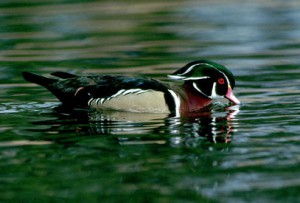
Wood ducks are one of the most colorful ducks in North America. Breeding males showcase an unbelievable combination of colors including a red bill and eyes, a metallic purplish-green crested head, black cheeks with thick white stripes, a maroon chest and rump, black and blue wings, dark yellow sides, and a white belly. The drab grayish-brown females are most easily recognized by their white eye ring and crested head.

A pair of wood ducks with the more drably colored female in the foreground. Photo: USFWS National Digital Library
Another distinguishing characteristic of wood ducks is their habit of nesting in Florida. Few species of ducks do this.
In Florida, wood ducks begin laying eggs in cavities during late January. They prefer cavities located within a half mile of permanent water bodies. They like cavities in large trees that have clear access to a large entry hole, and shrubs nearby to offer protection for newly-hatched ducklings.
In areas with few large cavity trees, nest boxes can provide alternative locations to nest. Nest boxes intended for wood ducks should be made of natural wood: cedar is a good option because it weathers well. Boxes should be mounted with the entrance hole 6 or more feet above the ground or the surface of the water (if placed over a pond or swamp). Nesting hens will appreciate you placing some cedar wood shavings in the bottom of the box to serve as nesting material. Adding a predator guard below the nest box will greatly increase the chances the hen and her eggs/ducklings don’t get eaten by snakes or raccoons.
It’s best to have nest boxes in place before egg laying begins, which is right about now: late January. However, it’s never too late in the year to put up a new nest box. A box put out later in the year may be useful for a late-nesting hen. Many females have more than one brood during the long nesting long season which won’t end until late summer, so opportunities exist for a nest box installed later in the year to get used.
Wood ducks were given their name because they spend much of their time in wooded swamps, ponds, creeks, rivers, and freshwater wetlands. They prefer bodies of water that have 25-50% open water with 50-75% vegetative cover (a mix of shrubs, emergent plants, and trees) where they can hide and feed.
Wood ducks are sometimes called the “acorn duck” because of their fondness for these treats that fall from oak trees. They have a special preference for acorns from water oaks, laurel oaks, and shumard oaks. They also enjoy duck weed, smartweed, waterlily, seeds from many sedges, rushes, and grasses, as well as fruits from native trees and shrubs and occasionally invertebrates (spiders, insects, snails, crawfish).
Several adaptations differentiate wood ducks from other waterfowl and equip them for life in both woods and water. Well-developed toes and claws allow them to grab onto tree branches while perching. The placement of their legs near the center of their bodies allows them to walk on land more gracefully than most other ducks. Their broad wings and long wide tail increase maneuverability while flying to their cavity nest.
To learn more about wood ducks and what you can do to provide habitat for them, see this publication from UF/IFAS Extension.
Author: Holly Ober – holly.ober@ufl.edu
I am an Associate Professor and Extension Specialist in the Department of Wildlife Ecology and Conservation. My research covers wildlife ecology, habitat management, and identifying creative ways to cope with nuisance wildlife.
![]()
Posted: February 1, 2015
Category: Natural Resources, Wildlife
Tags: Could, Ducks, Help, Panhandle Outdoors, This, Time, Wood, Year


